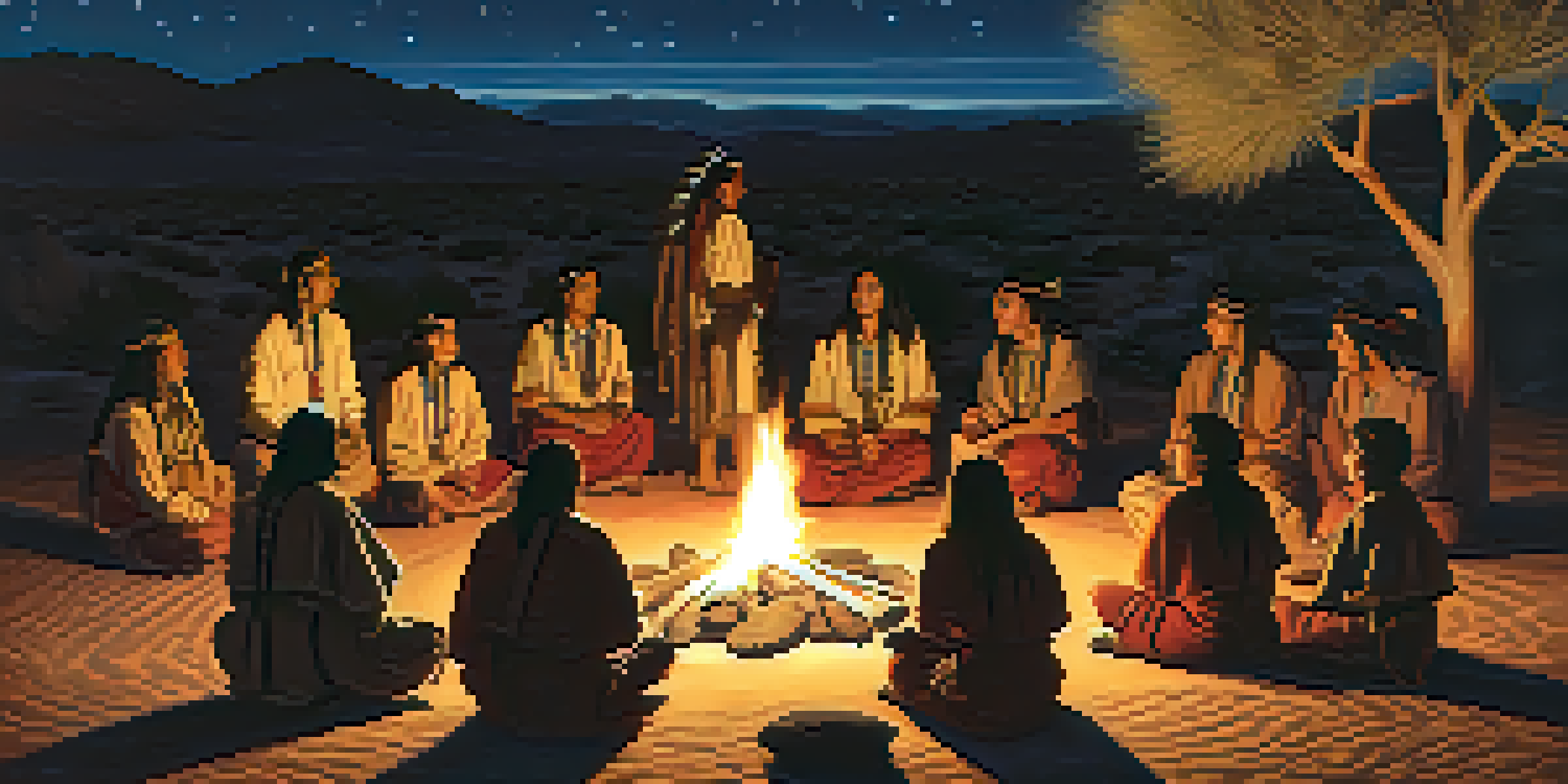Peyote Ceremonies: Bridging Different Religious Traditions

Understanding Peyote: A Sacred Cactus in Tradition
Peyote is a small cactus that has been used for thousands of years, particularly by Native American tribes. Known scientifically as Lophophora williamsii, this plant contains mescaline, a psychoactive compound that induces altered states of consciousness. For many indigenous people, peyote is not just a plant; it is a sacred gift that facilitates spiritual connections and healing.
The use of peyote is a sacred practice that connects us to the divine and to each other.
In the context of religious ceremonies, peyote serves as a bridge between the physical and spiritual worlds. Participants often consume the cactus in a ceremonial setting, which is deeply rooted in tradition and community. This ritualistic use goes beyond recreation; it aims to foster insights into life’s mysteries and promote communal bonding.
The reverence for peyote highlights its importance in various cultures, showcasing how a single plant can serve multiple spiritual purposes. As we explore its use in different religious traditions, we can appreciate not just its psychoactive effects but also its deep cultural significance.
Peyote in Native American Spiritual Traditions
In many Native American cultures, peyote ceremonies are integral to spiritual practices. The Native American Church (NAC), which emerged in the early 20th century, has formalized the use of peyote in its rituals, combining elements of Christianity and indigenous beliefs. This unique blend illustrates how peyote can be a conduit for both personal reflection and communal worship.

During these ceremonies, participants gather in a sacred space, often at night, to consume peyote and engage in prayer and song. The experience is viewed as a path to healing, guidance, and enlightenment. It is not uncommon for participants to report profound spiritual experiences, which can lead to personal transformations.
Peyote's Spiritual Significance
Peyote is revered in various Native American cultures as a sacred tool for spiritual connection and healing.
These ceremonies also serve a vital social function, bringing together individuals from various backgrounds to share in a common experience. This aspect of communal participation emphasizes the importance of connection, not only to the divine but also to one another.
Christian Influences and Syncretism in Peyote Use
The incorporation of peyote into Christian practices reveals the dynamic nature of religious traditions. Some Native American Church members identify as Christians and integrate biblical teachings with traditional beliefs. This syncretism highlights how peyote can act as a bridge between seemingly disparate spiritual paths.
Spirituality transcends boundaries; it is a bridge that connects diverse traditions and experiences.
For example, many ceremonies feature prayers that invoke Christian imagery alongside traditional Native American elements. This blending of practices allows followers to embrace their cultural heritage while also finding meaning in Christian teachings. The result is a unique expression of faith that honors both traditions.
This fusion of beliefs demonstrates the adaptability of spiritual practices, showing that faith can evolve over time while still maintaining core values. It encourages a broader understanding of spirituality that transcends rigid definitions.
Peyote and Global Spiritual Movements
While peyote is most commonly associated with Native American traditions, its influence has spread globally. Various spiritual movements worldwide have begun to explore the use of entheogens, or psychoactive substances, as tools for spiritual awakening. Peyote, in particular, has garnered interest from those seeking alternative paths to enlightenment.
In recent years, there has been a growing movement advocating for the responsible use of peyote in spiritual contexts. This interest often stems from a desire to connect with nature and explore consciousness in new ways. As more people engage with peyote, discussions around ethics, cultural appropriation, and respect for indigenous practices become increasingly important.
Cultural Respect is Essential
As interest in peyote grows outside indigenous communities, it's crucial to approach its practices with respect and understanding to avoid cultural appropriation.
This global curiosity about peyote highlights the universal quest for spiritual understanding and connection. It also raises questions about how various cultures can share their traditions while honoring their origins.
Cultural Appropriation vs. Cultural Appreciation
As interest in peyote ceremonies expands beyond Native American communities, it brings forth the critical issue of cultural appropriation versus appreciation. While many are eager to learn from these rich traditions, it is essential to approach them with respect and understanding. Cultural appropriation occurs when elements of a culture are taken without acknowledgment or respect for their significance.
To genuinely appreciate peyote ceremonies, it is crucial to engage with the culture from which they stem. This means listening to indigenous voices, understanding the historical context, and recognizing the sacredness of the practices involved. Engaging respectfully can lead to meaningful intercultural exchanges and mutual learning.
Ultimately, the goal should be to foster dialogue and understanding rather than exploitation. By honoring the traditions and the people behind them, we can create a space for genuine appreciation and shared spiritual growth.
Legality and Ethical Considerations of Peyote Use
The legal status of peyote varies widely across different regions, which adds another layer of complexity to its use in spiritual ceremonies. In the United States, the Native American Church is legally permitted to use peyote as a sacrament, but this protection does not extend to non-indigenous users. Understanding these legal frameworks is essential for anyone interested in participating in peyote ceremonies.
Beyond legality, ethical considerations regarding peyote's sustainability are also pressing. Overharvesting of peyote can threaten its existence, prompting discussions about responsible use and conservation. Participants and advocates alike must consider how to incorporate peyote into their practices without jeopardizing its future.
Legal and Ethical Challenges
The use of peyote is subject to complex legal frameworks and sustainability concerns, emphasizing the need for informed and responsible participation.
These legal and ethical dimensions emphasize the importance of informed participation. By being aware of these factors, individuals can engage in peyote ceremonies in a way that is respectful, sustainable, and aligned with the values of the communities that hold it sacred.
The Future of Peyote Ceremonies: A Path Forward
As we look to the future, peyote ceremonies continue to evolve, reflecting broader societal changes and ongoing dialogues about spirituality. Increasing interest in psychedelics for mental health and spiritual growth has led to a renewed focus on traditional practices. This presents both opportunities and challenges for indigenous communities.
Advocates for peyote usage often emphasize the importance of preserving traditional methods while allowing for modern interpretations. This balance can help ensure that peyote remains a sacred tool for spiritual exploration, rather than becoming commodified or misused. Engaging in thoughtful discussions about the future of these ceremonies can lead to more inclusive practices.

Ultimately, the future of peyote ceremonies lies in collaboration and respect. By bridging different religious traditions and fostering understanding, we can ensure that these sacred practices remain meaningful for generations to come.